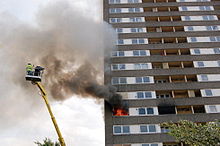- The Dalmarnock Fire Tests
-
The Dalmarnock Fire Tests are a series of fire experiments that were conducted in a real high-rise building in the United Kingdom.
In 2006, the BRE Centre for Fire Safety Engineering at the University of Edinburgh, conducted this series of large-scale fire tests in a high-rise building in collaboration with the BBC series Horizon, EPSRC, Glasgow Housing Authority, Strathclyde Fire Brigade, Glasgow Caledonian University, Lion TV, Arup, BRE, Xtralis and Powerwall Systems Ltd, among other contributors.
Contents
Description
The building, a 23-storey reinforced-concrete tower located at 4 Millerfield Place in Dalmarnock, Glasgow, was scheduled for demolition and hence was evacuated of tenants. Three main experiments were conducted over two days, from 25 to 26 July 2006. Tests One and Two took place in identical flats, the main compartment of which had been fitted with regular living room and office furniture, arranged to provide conditions that favour repeatability. Test Three was a smaller smoke management experiment held in one of the two main emergency exit stairwells.
Tests One and Two were fully instrumented with a high sensor density, including measurements of temperature, incident heat, gas velocities, smoke obscuration, wall temperature and structure deflection, among others. The tests varied in that Test One allowed the fire to develop freely to post-flashover conditions, while Test Two incorporated sensor-informed ventilation management and was extinguished before post-flashover conditions were attained. Both tests had approximately 300 sensors monitoring several different characteristics of the fire environment, but Test One had about 160 additional sensors monitoring the structural response.
These experiments endeavoured to establish a highly-monitored fire in a realistic residential scenario, allowing for several different modern fire safety engineering tools to be tested. The comprehensive set of data collected is being used for validation of different mathematical models of fire dynamics. Because the data has a spatial resolution high enough to be comparable to typical resolutions of CFD fire models, the tests are specially well suited for validation of this type of models. The tests also form an integral part of the research conducted for the FireGrid research project,[1] that is, the development of emergency control systems that use continuous sensor data and computer modelling, to provide forecast of the fire evolution and aid the efficient deployment of resources.
Analysis and dissemination
Analysis of the copious amounts of test data collected will take several years to complete. Nevertheless, there has been significant dissemination activities of the findings to date in the form of several related journal and conference papers; a one-day seminar introducing the tests and highlighting the analysis and conclusions to date (held in Edinburgh, November 2007);[2] and a book detailing the tests and analysis completed to date was published in November 2007. The book, entitled The Dalmarnock Fire Tests: Experiments and Modelling,[3] comprises material covering characterisation and comparison of both the Test One and Test Two fires; experimental error analysis; evaluation of the fire detection systems; calculation of heat transfer to the structure; analysis of the structural behaviour; evaluation of ceiling Fibre Reinforced Polymer (FRP) performance; and comparison of both a priori and a posteriori computational fire, modelling against experimental data allowing for an evaluation of such the current use of tools.
The overall aim of the Dalmarnock fire tests is to improve understanding of how building fire emergencies can be handled in the most effective manner, while providing further insights into the fundamentals of compartment fire dynamics and fire-induced structural behaviour.
References
- ^ "FireGrid Project" (HTML). http://www.firegrid.org. Retrieved 2008-09-13.
- ^ "2007 FireSeat The Dalmarnock Fire Tests: Experiments and Modelling" (HTML). http://www.see.ed.ac.uk/FIRESEAT/2007.html. Retrieved 2008-09-13.
- ^ "The Dalmarnock Fire Tests: Experiments and Modelling" (HTML). http://www.amazon.co.uk/Dalmarnock-Fire-Tests-Experiments-Modelling/dp/0955749700. Retrieved 2008-09-13.
See also
External links
- Official website of The Dalmarnock Tests
- FireGrid Project
- "Skyscraper Fire Fighters", Horizon, aired 24 April 2007 on BBC Two
- "Glasgow tower block to shed light on 9/11 fire", The Scotsman
- Digital collection of papers on The Dalmarnock Fire Tests at the Edinburgh Research Archive
Categories:- Fire protection
- Building engineering
- Firefighting
- Fire prevention
Wikimedia Foundation. 2010.

